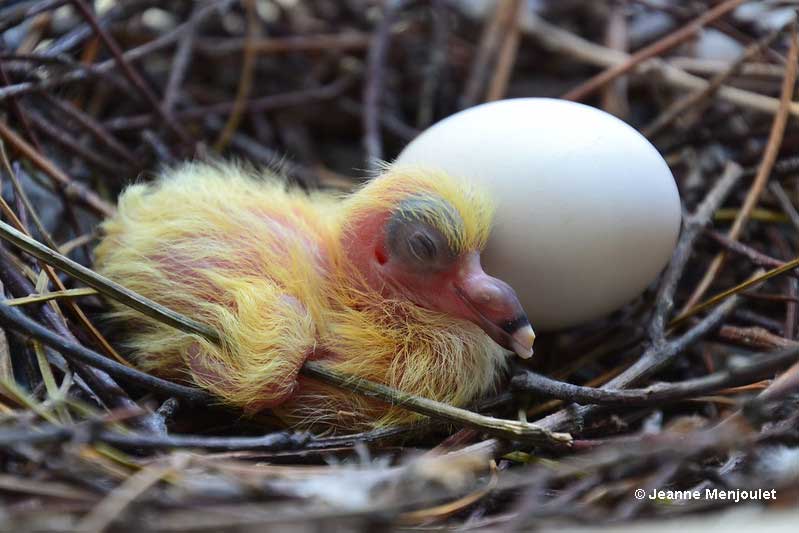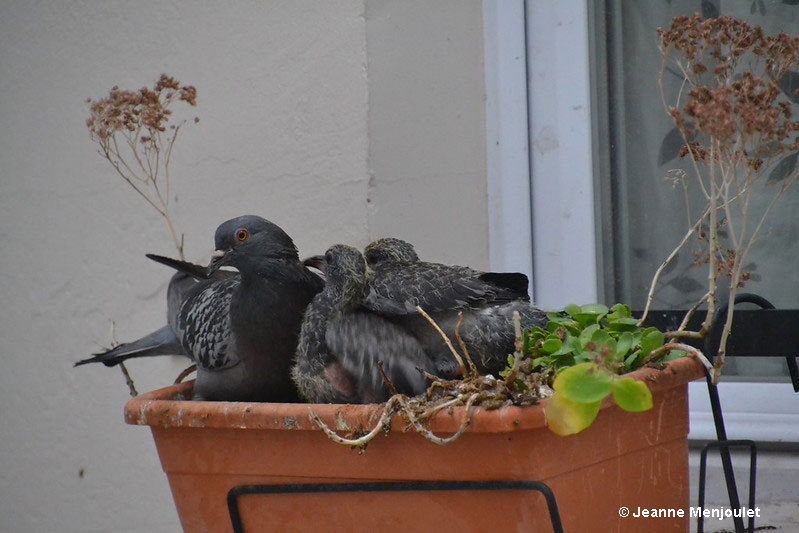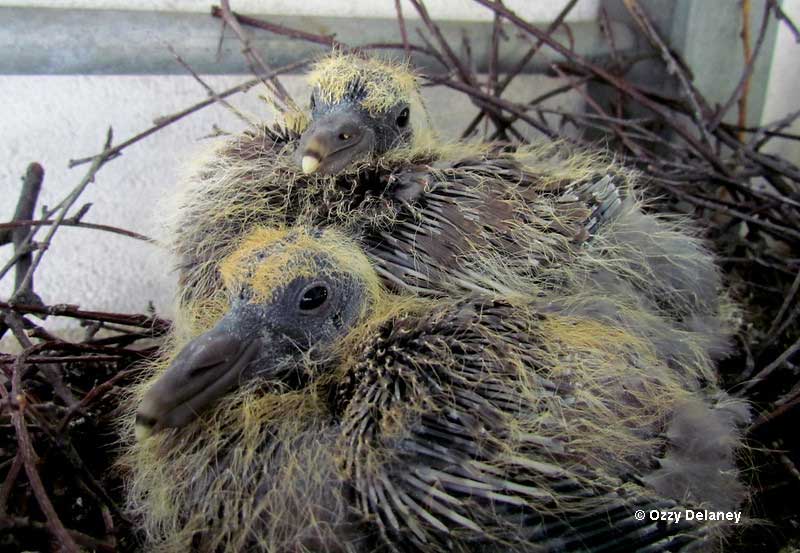
Pigeons are some of the more commonly seen birds. We find pigeons on city streets, in parks, roosting and cooing on buildings, and flocking in farm fields. But have you ever seen a baby pigeon?
Baby pigeons stay hidden from our view – they start off as tiny hatchlings who are completely helpless.
- Nest
- What Does A Baby Pigeon Look Like?
- How To Tell Baby Pigeons Apart?
- What Do Baby Pigeons Eat?
- Why do we hardly ever see baby pigeons?
- What do pigeon eggs look like?
- What is a chick pigeon called?
- How long does a pigeon stay a baby?
- Is it OK to pick up a baby pigeon?
- What is the lifespan of a pigeon?
- Do pigeons mate for life?
As with other birds, pigeons build plenty of nests, lay eggs, and take care of their young, but because the nestlings are so vulnerable, their parents try their best to keep them hidden.
Like many baby birds, when pigeons are born, they are helpless and completely rely on their parents. If a predator finds them, it doesn’t take much effort to catch them.
Since baby pigeons are common but rarely seen, we created this article to answer most of the questions frequently asked about these cute little birds.
Nest
The male Rock Pigeon (also known as Rock Doves) chooses a nesting site and makes cooing calls to attract a mate. The nesting site is a ledge on a building or other flat surface covered by a roof or other structure.
If an old pigeon nest is present, that is often used as a base for the new nest. Such situations approximate the cliff ledges or caves used as nest sites by Rock Pigeons in wilder places. If the male pigeon attracts a female, she sits on the nesting site and coos as he brings her small sticks or other stick-like objects.
The female pigeon places and arranges the sticks and twigs around her to make a clumsy, shallow structure and lays two white eggs that weigh 15 to 17 grams each.
Both parents incubate the eggs, with males incubating during the middle of the day, and females sitting on the eggs in the late afternoon, night, and early morning.
Read more: How long do pigeons live?
The eggs hatch after 18 days, and the young are naked except for some yellowish down feathers. During the first week of their lives, they can barely move, only opening their mouths to be fed “crop milk,” a secretion made by both parents that is high in fat and protein.
After a week, the baby pigeons are fed a diet that consists mostly of seeds, they quickly grow and attain feathers, and leave the nest around 30 days after hatching. In cold weather, baby pigeons may remain in the nest up to 45 days after hatching.
| Incubation | 18 days |
| In the nest | 30-45 days |
| Hatching as | altricial chicks |
| Parental care | no care after leaving the nest |
| Sexual maturity | at 6-7 months, sometimes earlier |
| Expected lifespan | 2-3 years (in the wild) |
What Does A Baby Pigeon Look Like?
Newborns, or newly hatched baby pigeons look similar to other “altricial” birds. This is the term for baby birds born naked or nearly naked and helpless.
In the case of baby pigeons, they are born with their eyes closed, have some stringy, yellowish down feathers, and are around two inches in length. Their skin is gray and pink, the feet, wings, and pink bill look too big for their bodies, and they weigh around 15 grams.
After four or five days, the baby pigeons open their eyes, make begging sounds, stretch their neck to get food, and can move their wings. A week after hatching, they move towards their parents to get food and can make hissing noises and snap their bills at potential predators.
Baby pigeons grow fast and gain four to eight grams per day, but after a week, put on 20 grams of weight each day, weighing up to 350 grams by the time they leave the nest.
Related: Baby Birds – From Hatching to Adulthood
They start to grow feathers five days after hatching, are fairly well-feathered after two weeks, and have most of their feathers a month after hatching.
When baby pigeons leave the nest, they look like small adults with fewer feathers, especially around the head and neck. Fledgling pigeons stay near the nest for a week or more but fend for themselves. This is the time baby pigeons will start looking like adults when their adult plumage.
For other species of pigeons, for example, European Wood Pigeons, the process is fairly similar.
How To Tell Baby Pigeons Apart?
Although it is very hard to see a baby pigeon in the nest, hatchlings are nearly naked with yellowish down feathers and have a rather big, pinkish bill.
The fledglings or “squabs” have dark feathers and resemble adults but have much less feathering on the head and neck. When the young birds leave the nest, they can look a lot like adults but tend to be smaller.
However, they quickly grow to adult size and have plumage that resembles that of the adult except for lacking iridescent colors on the neck, having a grayish-pink base of the bill, and having dark brown eyes instead of reddish eyes.
What Do Baby Pigeons Eat?
After hatching, both parents feed juvenile pigeons a mixture of fat and protein called “crop milk.” The babies eat this important, regurgitated food four times a day for a week.
Related: What do baby birds eat?
A week after hatching, juveniles beg for food much more and are fed seeds, some fruits, and occasional invertebrates twice per day.
Why do we hardly ever see baby pigeons?
We hardly ever see baby pigeons because they stay hidden in nests until they are nearly indistinguishable from adults. Pigeons build their nests in high, concealed spots like building ledges, church steeples, and bridges—areas inaccessible to both predators and people. These hidden locations keep baby pigeons, or squabs, out of sight throughout their development.
Unlike many birds, squabs remain in the nest for 4 to 6 weeks, maturing fully before venturing out. By this time, they are almost the same size as adult pigeons and have developed similar plumage, making them hard to identify as juveniles.
This prolonged nesting period, combined with pigeons’ instinct to choose discreet locations, means baby pigeons are rarely seen by the public. While pigeons are highly visible in urban environments, their nesting behavior ensures their young stay well-hidden until they’re ready to join the adult population.
What do pigeon eggs look like?
Pigeon eggs are smooth, oval, and pure white, often with a slightly glossy surface. Each clutch typically consists of two eggs, laid one to two days apart. They are much smaller than chicken eggs, measuring about 3 to 4 centimeters in length and weighing approximately 15 to 20 grams.
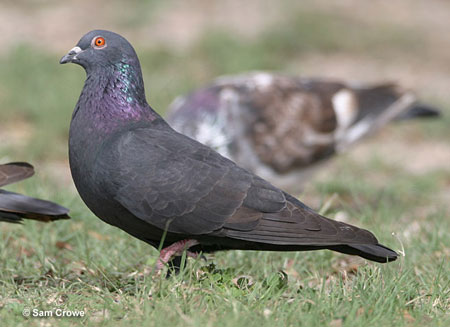
The eggs are incubated by both parent pigeons, with the male and female taking turns sitting on the nest to keep them warm. The incubation period lasts around 17 to 19 days, after which the chicks, or squabs, hatch. Newly hatched squabs are altricial, meaning they are born blind and featherless, requiring full parental care.
Pigeons often nest in hidden or elevated areas, such as ledges, balconies, or secluded urban spots. Their choice of nesting sites and the inconspicuous appearance of the eggs contribute to why they are not commonly seen by most people.
What is a chick pigeon called?
A young pigeon is most commonly called a squab, especially in the context of its early life stage, when it is still in the nest and being fed by its parents. The term “squab” is often used specifically for baby pigeons that are not yet fully fledged or independent.
Other names include:
- Peeps: This nickname reflects the high-pitched peeping sounds they make as chicks.
- Squeakers or Squealers: These terms describe the squeaky, plaintive noises young pigeons produce, especially when begging for food from their parents.
- Pipers: Occasionally used to describe young pigeons, this name may come from their soft, piping calls.
These names vary depending on regional preferences or specific stages of the bird’s development, but “squab” remains the most widely recognized and used term.
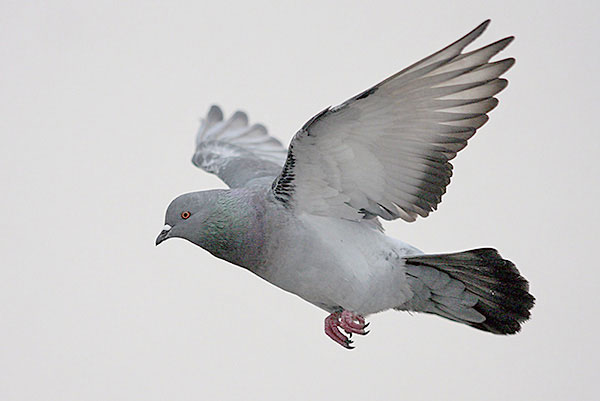
Photograph © Greg Lavaty
How long does a pigeon stay a baby?
Baby pigeons, or squabs, remain in the “chick” stage for about 30 to 35 days, which corresponds to the time they spend in the nest before fledging. During this period, they are completely dependent on their parents for food and protection.
For the first week or so, squabs are fed exclusively on “crop milk,” a nutrient-rich secretion produced by both parent pigeons. As they grow, their diet gradually transitions to include partially digested seeds and grains.
By the time they leave the nest, squabs have developed adult-like feathers and are nearly the same size as their parents. However, they may still be considered juveniles for several more weeks, as they continue to refine their flying and foraging skills. Once they leave the nest, they integrate into the adult pigeon population, making it difficult to distinguish them from fully mature pigeons.
Is it OK to pick up a baby pigeon?
Yes, it is generally okay to pick up a baby pigeon if necessary, but only to place it in a safer spot or back into its nest. If you find a baby pigeon on the ground, follow these steps to ensure the best outcome:
- Assess the Situation: Check if the pigeon is truly in need of help. If it has feathers and is hopping or fluttering around, it might be a fledgling learning to fly, and its parents are likely nearby. In this case, it’s best to leave it alone unless it is in immediate danger.
- Return to the Nest: If the baby pigeon is featherless or very young (a squab), it likely fell from the nest. Gently pick it up and return it to its nest if you can locate it. Pigeons do not abandon their young due to human scent, so touching the bird won’t discourage the parents from caring for it.
- Place in a Safer Spot: If the nest is inaccessible or destroyed, you can create a makeshift nest close to where the original nest was and place the baby there. Ensure it is in a secure location, away from predators and harsh weather.
- Monitor for Parental Return: Observe from a distance to see if the parents return to care for the baby. Pigeons are attentive parents and will usually resume feeding their young once they feel safe.
If the parents don’t return after several hours or the baby appears injured or sick, it may need professional help. Contact a local wildlife rehabilitator or rescue organization for guidance. Avoid attempting to care for the baby pigeon yourself unless you have the proper knowledge and resources.
What is the lifespan of a pigeon?
The lifespan of a pigeon varies significantly depending on its environment:
- Wild Pigeons: In the wild, pigeons typically live around 3 to 6 years. Their shorter lifespan is due to various risks, including predators, disease, harsh weather, and accidents in urban environments.
- Captive Pigeons: In captivity, where they are protected from predators and provided with consistent food, shelter, and care, pigeons can live much longer. Captive pigeons often reach 10 to 15 years or more.
- Record Lifespan: Some pigeons have been known to live exceptionally long lives in captivity. For instance, a famous homing pigeon reportedly lived for 30 years, demonstrating the potential longevity of these birds when given optimal care.
Factors such as diet, health, and environmental stressors all play a role in determining a pigeon’s lifespan. Domesticated or well-cared-for pigeons benefit greatly from reduced risks and better overall conditions, allowing them to live far beyond the typical lifespan of their wild counterparts.
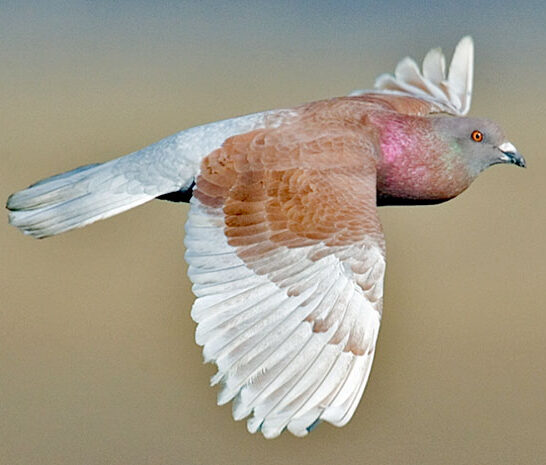
Do pigeons mate for life?
Yes, pigeons tend to mate for life and form strong pair bonds. Once a male and female pigeon pair up, they usually remain together, cooperating in nesting, incubating eggs, and raising their chicks. Their loyalty to each other helps ensure the survival of their offspring.
However, there are exceptions:
- Loss of a Mate: If one pigeon’s mate dies or goes missing, the surviving pigeon may seek another partner to continue breeding.
- Failed Pair Bonds: In rare cases, a pigeon may “divorce” a mate if the pair proves unsuccessful in raising young, though this behavior is less common.
Pigeons reinforce their bond by engaging in mutual preening, courtship displays, and cooing. These behaviors not only maintain their relationship but also strengthen their partnership for parenting duties. Despite their reputation for monogamy, pigeons are adaptable and prioritize reproduction, which is why they may form new bonds when necessary.
Read next: What to do if you find a baby bird


